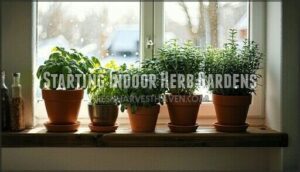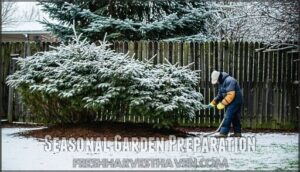This site is supported by our readers. We may earn a commission, at no cost to you, if you purchase through links.

You can start indoor herb gardens, grow cold-hardy vegetables like kale and Brussels sprouts, and create stunning container displays with evergreens and winter berries.
Plan next year’s layout while reviewing seed catalogs, prune dormant trees, and build wildlife feeders to attract birds.
Don’t overlook the magic of winter interest plants – ornamental grasses and colorful bark add texture when everything else sleeps.
These seasonal winter garden ideas transform quiet months into productive preparation time, setting you up for spectacular spring success while keeping your green thumb active year-round, and utilizing winter berries and ornamental grasses to enhance your garden.
Table Of Contents
- Key Takeaways
- Winter Garden Planning
- Indoor Gardening Tips
- Outdoor Winter Maintenance
- Winter Gardening Activities
- Seasonal Garden Preparation
- Frequently Asked Questions (FAQs)
- What month do you start a winter garden?
- What vegetables go in the winter garden?
- What to do in winter for a garden?
- What crops are good for winter garden?
- What are some winter landscaping ideas?
- What are the best Winter Garden ideas?
- Is gardening in winter a good idea?
- How do you start a garden in the winter?
- Should you plant perennials for winter?
- Why should you invest in a Winter Garden?
- Conclusion
Key Takeaways
- You’ll turn winter downtime into productive planning time by reviewing seed catalogs, mapping garden layouts, and organizing next year’s growing strategy while staying warm indoors.
- You can grow fresh food year-round with cold-hardy vegetables like kale and Brussels sprouts outdoors, plus indoor herb gardens and microgreens that thrive in winter conditions.
- You’ll create stunning winter landscapes using evergreen structures, colorful bark plants, ornamental grasses, and strategic lighting to maintain visual interest when other plants go dormant.
- You’ll support local wildlife and maintain your garden’s health through winter bird feeders, protective mulching, dormant season pruning, and composting activities that prepare your space for spring success.
Winter Garden Planning
Winter’s quiet months offer the perfect opportunity to plan your garden’s future while staying warm indoors.
You’ll discover that thoughtful planning now sets the foundation for a thriving garden when spring arrives.
Creating Garden Layouts
While winter offers fewer daylight hours, it’s your best time for thoughtful garden planning. Map your yard’s sunlight considerations throughout the day, noting which areas get morning versus afternoon light.
Focus on structure placement by positioning permanent features like trellises and raised beds first. Create pathway design that connects key areas while considering seasonal interest.
Group plants with similar needs together for efficient care. Consider assessing climate and soil for maximum growth.
This winter garden planning approach guarantees your spring garden designs maximize both beauty and functionality.
Selecting Seeds and Bulbs
Smart gardeners know that successful winter planning starts with choosing the right seeds and bulbs. Here are three essential selection strategies:
- Prioritize cold-hardy varieties with proven germination rates above 85% for reliable spring results
- Select disease-resistant cultivars from reputable seed catalogs to reduce crop failure by up to 60%
- Choose locally adapted heirloom varieties that increase winter survival rates by 15-25%
When seed ordering, focus on seed viability by checking expiration dates and storage conditions. Variety selection should emphasize bulb hardiness zones matching your climate. Flower bulbs like tulips require specific planting depth (6-8 inches), while smaller bulbs need only 3-4 inches. To guarantee a successful winter garden, consider purchasing high quality seeds.
Store purchases in cool, dry conditions at 35-50°F to maintain quality. Seed starting success depends on proper germination rates and timing. Review seed catalogs early for best selection, as popular varieties sell out quickly during peak seed selection season.
successful growth
Maintaining Seed Journal
A detailed seed journal transforms guesswork into strategic planning.
Track each variety’s performance, germination rates, and seasonal timing to refine your approach.
| Journal Section | What to Record |
|---|---|
| Seed Inventory | Variety names, purchase dates, storage locations |
| Tracking Experiments | Germination success, planting methods, growth patterns |
| Long-Term Analysis | Best performers, failures, spring planning notes |
Document seed starting dates, seed viability results, and lessons learned.
Your journal becomes your personal seed catalog, guiding future seed ordering decisions and improving garden success rates year after year.
Reviewing Seed Catalogs
Garden catalogs offer inspiration and endless possibilities for your winter garden ideas.
These colorful guides help you discover new varieties while planning your dream space.
- Browse new varieties – Explore heirloom seeds and unique cultivars that’ll make your garden stand out from neighbors.
- Check planting zones – Match seeds to your climate zone to guarantee successful growth and avoid disappointment.
- Compare organic options – Prioritize chemical-free seeds for healthier plants and better garden inspiration.
- Plan seed storage – Order early since popular varieties sell out, then store properly in cool, dry conditions.
Indoor Gardening Tips
When winter weather drives you indoors, you can still keep your green thumb active with rewarding indoor gardening projects.
From growing fresh herbs on your windowsill to sprouting nutrient-packed microgreens in just days, these indoor activities let you garden year-round while brightening your home with living plants.
Starting Indoor Herb Gardens
Fresh kitchen herbs transform winter cooking into a flavorful adventure. Herb selection matters—choose basil, rosemary, sage, and thyme for versatility.
Lighting needs require south-facing windows or grow lights for healthy growth. Container choices like terra cotta pots provide excellent drainage for herbs preferring drier soil.
Master watering techniques by checking soil moisture regularly. Pest control means inspecting leaves weekly for early detection.
For ideal growth, consider grouping herbs by light. Your indoor herb garden brings fresh flavors to winter meals while keeping your indoor gardening skills sharp.
Growing Microgreens
These tiny powerhouses pack up to 40 times more microgreen nutrition than mature plants.
Choose quality seed selection like radish microgreens for spicy flavor. For ideal results, consider specialized options available.
Use sterile growing mediums in shallow trays, maintaining consistent moisture. Provide 4-6 hours of lighting needs daily at 64-75°F.
Your winter garden thrives with proper indoor seed starting. Harvesting tips: snip above soil when cotyledons appear, typically 7-21 days.
These garden microgreens deliver fresh nutrition year-round.
Creating Terrariums
When winter arrives, creating terrariums becomes an ideal DIY project for indoor gardening enthusiasts.
Choose clear glass containers, then layer gravel, charcoal, and soil to build healthy terrarium ecosystems.
Your plant selection should focus on succulents and other low-maintenance varieties that thrive in enclosed environments.
Container choices range from mason jars to elaborate glass globes.
Monitor humidity control carefully—too much moisture kills plants faster than neglect.
Regular terrarium maintenance involves removing dead leaves and checking soil moisture levels.
Propagating Houseplants
Building on your terrarium success, houseplant propagation lets you multiply your collection without spending money.
This rewarding winter activity transforms single plants into thriving colonies using simple techniques.
Here are five effective propagation methods:
- Stem cuttings – Snip healthy stems and root them in water or soil
- Leaf propagation – Remove leaves from succulents and wait for baby plants to emerge
- Air layering – Wrap moss around stems while still attached to encourage root development
- Division methods – Separate root clumps from mature plants like snake plants or pothos
- Water propagation – Place cuttings in jars and watch roots develop over weeks
Outdoor Winter Maintenance
Your winter garden doesn’t have to go dormant just because the temperature drops.
With proper outdoor maintenance, you’ll keep your landscape healthy and create stunning visual interest that’ll make your neighbors wonder how you manage such beauty in the cold months, which is a result of proper maintenance.
Pruning Dormant Plants
Winter garden pruning transforms sleeping plants into healthier specimens.
Sharp, disinfected tools make clean cuts that heal faster.
Pruning timing matters most during dormancy when plants won’t stress from cuts.
Focus on removing dead, damaged, or crossing branches first.
Pruning young trees shapes their future growth patterns.
Skip wound sealers—they actually slow healing.
Pruning shrubs now prevents spring growth problems.
Dormancy pruning benefits include better air circulation and disease prevention.
Caring for Local Wildlife
After pruning dormant plants, consistently support local wildlife throughout winter’s challenging months.
Create bird-friendly gardens with feeders offering high-energy seeds and suet. Install bee hotels using untreated wood with drilled holes for nesting pollinators. Leave seed heads intact—they’re natural wildlife feeders that attract various species.
- Fill bird feeders with black oil sunflower seeds for maximum nutrition
- Provide heated birdbaths so creatures can drink when water freezes
- Maintain leaf cover in flower beds to shelter beneficial insects
- Create brush piles from pruned branches for small mammal protection
- Practice wildlife gardening by avoiding pesticides that harm beneficial species
Planting Winter Interest Plants
Strategic evergreen selection creates year-round structure while winter blooms and colorful bark add seasonal excitement.
Choose cold hardiness varieties like dogwood for vibrant stems, holly for berries/seedheads, and ornamental grasses for foliage texture.
These winter interest plants transform dormant landscapes into enchanting displays that’ll make neighbors wonder how you mastered winter garden design so effortlessly.
Consider browsing options for winter plant varieties to find the perfect fit.
Winter Gardening Activities
Winter doesn’t mean your gardening efforts have to hibernate—it’s actually the perfect time to tackle productive outdoor projects that’ll set you up for success come spring.
From growing hardy vegetables that laugh at frost to creating wildlife havens that bring life to your winter landscape, these activities keep your green thumb active all season long.
Growing Cold-Hardy Vegetables
Cold-hardy vegetables transform your winter garden into a productive oasis.
These winter vegetable varieties thrive in challenging conditions, making cold frame gardening both rewarding and practical.
Here’s your action plan for winter garden harvesting success:
- Choose pest-resistant crops like kale and spinach that handle soil temperature management naturally
- Plant coldhardy vegetables including carrots and mache for continuous harvests
- Use row covers to protect tender cold hardy crops from harsh weather
- Time plantings strategically for extending harvest season through succession planting
Winter vegetables actually taste sweeter after frost exposure, so you’ll enjoy better flavors than summer crops!
Pruning Shrubs and Trees
Sharp pruning shears become your best friend when dormant foliage awaits winter garden maintenance. Dormancy pruning removes dead branches while tool maintenance keeps cuts clean and precise.
Winter’s dormancy is when your garden tools work their magic—sharp blades make all the difference.
Focus on shrub shaping and tree health through strategic pruning techniques that promote spring growth.
| Pruning Task | Best Timing |
|---|---|
| Dead branch removal | Late winter |
| Shape deciduous trees | February-March |
| Shrub rejuvenation | Before bud break |
| Crossing branch cuts | Dormant season |
| Wound treatment | Immediately after cuts |
Garden pruning during winter creates stronger plants for next season’s display.
Creating Winter Bird Feeders
Winter transforms your garden into a bustling bird café when you position bird feeders strategically. Choose seed selection that attracts local species—black oil sunflower seeds work like magic for most birds.
Feeder placement matters: position them where you can enjoy the show while keeping birds safe from predators.
- Squirrel proofing with baffles prevents these acrobatic bandits from emptying your feeders
- A nearby water source keeps feathered visitors hydrated and happy
- Regular feeder hygiene prevents disease and maintains a healthy feeding station
Bird watching enriches your winter garden experience immeasurably. Leaving some foliage provides natural shelters for wildlife.
Building Compost Heaps
Beyond just feeding birds, you can transform kitchen scraps into garden gold.
Build your compost heaps using sturdy bins, alternating compost materials like greens and browns.
Master layering techniques by mixing food waste with dry leaves.
Monitor compost temperature and maintain proper turning frequency weekly.
When troubleshooting compost, adjust moisture and airflow.
Your garden organic matter will decompose into rich garden compost by spring.
Seasonal Garden Preparation
As winter approaches, you’ll need to prepare your garden for the colder months ahead by protecting vulnerable plants and ensuring they survive until spring.
This seasonal preparation involves moving tender plants to safety, cutting back perennials, and adding protective mulch to shield roots from freezing temperatures.
Moving Tropical Plants Indoors
As temperatures drop, your tropical plants need winter protection through careful relocation indoors.
Winter’s chill signals rescue time – your tropical treasures need their cozy indoor sanctuary.
The acclimation process requires gradual adjustment to prevent shock, while proper light requirements mean positioning near bright windows.
Humidity control becomes critical in dry indoor air, and pest prevention starts with thorough inspection before bringing plants inside.
Many thrive with bright, indirect light, similar to bromeliads.
- Watch your leafy friends transform from outdoor adventurers to cozy indoor companions
- Feel the satisfaction of rescuing tender beauties from winter’s harsh grip
- Experience the joy of maintaining your tropical paradise year-round
- Discover peace of mind knowing your plants are safe and thriving indoors
Relocating Tender Perennials
Once you’ve brought your tropical plants indoors, protecting tender perennials requires similar care. Digging techniques matter most when relocating these plants—dig around the root ball six to twelve inches from the stem to preserve feeder roots. Water thoroughly twenty-four hours before digging to minimize root disturbance.
Container relocation works best using sterilized tools to prevent disease transmission.
For dormancy preparation, wrap roots in moist burlap if you can’t replant immediately. Cold storage in unheated garages or basements maintains ideal temperatures between thirty-five to fifty degrees.
The acclimation process takes seven to ten days, gradually introducing plants to their winter storage environment. This careful approach guarantees your tender perennials survive winter’s harsh conditions and return stronger to your winter garden next spring.
Cutting Back Hardy Perennials
Most gardeners know that winter pruning hardy perennials requires perfect timing. Wait until you see complete perennial dormancy before making cuts, as premature pruning can trigger unwanted regrowth. Sharp, clean tools make all the difference in preventing disease spread during cutting techniques.
Here’s your essential winter garden maintenance checklist:
- Timing matters – Wait for full dormancy before cutting
- Tool selection – Use sharp, sanitized pruning shears
- Check for disease signs before cutting
- Make clean cuts 2-3 inches above ground
- Post-cut care – Add compost around base
This approach guarantees your winter gardening tips lead to vigorous spring growth.
Adding Mulch for Protection
Once winter arrives, mulch becomes your garden’s best friend for protection. Think of mulch materials as a cozy blanket for your plants, providing insulation benefits while boosting soil health through the cold months.
Apply 2-3 inches around plant bases, avoiding stem contact for effective pest control. Quality mulching also delivers excellent weed suppression, keeping your winter garden soil healthy and ready for spring growth.
- Peace of mind knowing your plants are snug and protected from harsh freezes
- Satisfaction watching weeds stay away while your garden thrives underneath
- Excitement for spring when you’ll uncover healthier, stronger plants ready to flourish
Frequently Asked Questions (FAQs)
What month do you start a winter garden?
You’ll want to start planning your winter garden in late summer, around August or September. This gives you time to plant cold-hardy crops and prepare structures before frost arrives.
What vegetables go in the winter garden?
Ironically, while most gardens sleep through winter’s chill, you’ll find cold-hardy vegetables like kale, Brussels sprouts, leeks, onions, and garlic actually thrive in freezing temperatures.
What to do in winter for a garden?
You’ll spend winter planning your garden’s future, ordering seeds, testing soil, and maintaining equipment. Plant cold-hardy vegetables, support wildlife with feeders, and add lighting for evening beauty.
What crops are good for winter garden?
Cold-hardy vegetables like kale, Brussels sprouts, and leeks thrive in winter gardens. You’ll also succeed with onions, garlic, and hardy greens that handle frost beautifully.
What are some winter landscaping ideas?
Transform your winter yard with evergreen structures, frost-resistant plants like heather, and warm lighting.
Add raised beds, topiary sculptures, and bird feeders.
String lights create magical evening atmospheres while supporting wildlife through harsh months, creating a magical atmosphere.
What are the best Winter Garden ideas?
Nearly 78% of gardeners abandon their outdoor spaces during winter, yet you can create stunning cold-season displays.
Focus on evergreen structure, colorful stems, frost-resistant plants, and strategic lighting to maintain year-round beauty and functionality, which includes stunning cold-season displays.
Is gardening in winter a good idea?
Winter gardening offers excellent opportunities for planning, maintaining hardy plants, and supporting wildlife. You’ll find cold-hardy vegetables like kale thrive, while evergreens provide structure and beauty throughout the season.
How do you start a garden in the winter?
Like planting seeds in sleeping soil, you’ll start your winter garden by planning layouts, ordering seeds, testing soil, and growing cold-hardy crops like kale and microgreens indoors.
Should you plant perennials for winter?
You can plant perennials in winter, but timing matters. Hardy varieties like snowdrops and hellebores thrive when planted during dormancy. Choose frost-resistant options and guarantee proper soil drainage for success.
Why should you invest in a Winter Garden?
You’ll create year-round beauty while extending your growing season, attracting wildlife, and enjoying outdoor spaces even during cold months with proper planning.
Conclusion
Before smartphones ruled our pockets, gardeners relied on handwritten journals and dog-eared seed catalogs to plan their seasonal winter garden ideas.
You’ve learned that winter isn’t downtime—it’s preparation time. From starting indoor herbs to pruning dormant trees, these activities keep your hands busy while your outdoor garden rests.
Your planning now determines next year’s harvest success. Winter gardening connects you to nature’s rhythm, proving that passionate gardeners never truly stop growing.
- http://www.yourgreenpal.com/
- http://depts.washington.edu/uwbg/docs/WinterGardenMap2018.pdf
- https://sites.tufts.edu/pollinators/2019/11/why-you-should-leave-the-leaves-and-give-yourself-a-break-from-yard-work/
- https://extension.unh.edu/blog/2020/11/can-you-compost-winter
- https://tremendous-knitter-8234.kit.com/8aac07fdb8












